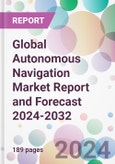According to the report, the global autonomous navigation market is projected to grow at a CAGR of 16.10% between 2024 and 2032 to reach a value of about USD 20.6 billion by 2032. . Aided by the rapid advancements in artificial intelligence (AI) and the escalating demand for autonomy across transportation and industrial sectors, the market is expected to grow significantly by 2032.
Autonomous navigation, an intricate fusion of sensor technologies, machine learning, and control systems, enables vehicles and machines to move and operate in their environments without human intervention. From self-driving cars and autonomous drones to robotic vacuum cleaners and industrial automation systems, the realm of autonomous navigation is expansive and continues to grow.
The precipitous rise of smart cities and the continuous push towards automation across sectors are pivotal in driving the autonomous navigation market growth. As urban centres globally strive for enhanced efficiency, reduced traffic congestion, and better transportation systems, autonomous navigation becomes a linchpin in realising these objectives. Self-driving cars, for instance, promise reduced traffic accidents, optimised traffic flow, and a drastic reduction in carbon emissions.
Simultaneously, the defense and aerospace sectors have been generating a steady autonomous navigation market demand. Drones equipped with advanced navigation systems are increasingly being deployed for surveillance, reconnaissance, and even delivery purposes. Such applications not only enhance operational efficiency but also reduce human exposure to potentially hazardous environments.
Moreover, with the relentless advancements in AI and machine learning, the capabilities of autonomous navigation systems have expanded exponentially. Systems today are capable of real-time data processing, dynamic decision-making, and adapting to ever-changing environments. These capabilities are particularly crucial in sectors like healthcare, where robotic assistants can now navigate hospital corridors autonomously, delivering supplies and aiding healthcare professionals.
As per the autonomous navigation market analysis, the integration of the Internet of Things (IoT) with autonomous navigation further amplifies the market's potential. Connected devices, constantly communicating and sharing data, can enhance the precision and reliability of autonomous navigation systems. This convergence of connectivity and autonomy is set to revolutionise sectors like logistics, where autonomous fleets can operate seamlessly, driven by real-time data and insights.
The global autonomous navigation market's horizon looks promising. As the confluence of technology, connectivity, and global trends toward automation shape the future, autonomous navigation stands at the forefront, promising a world characterised by efficiency, safety, and innovation.
Autonomous navigation, an intricate fusion of sensor technologies, machine learning, and control systems, enables vehicles and machines to move and operate in their environments without human intervention. From self-driving cars and autonomous drones to robotic vacuum cleaners and industrial automation systems, the realm of autonomous navigation is expansive and continues to grow.
The precipitous rise of smart cities and the continuous push towards automation across sectors are pivotal in driving the autonomous navigation market growth. As urban centres globally strive for enhanced efficiency, reduced traffic congestion, and better transportation systems, autonomous navigation becomes a linchpin in realising these objectives. Self-driving cars, for instance, promise reduced traffic accidents, optimised traffic flow, and a drastic reduction in carbon emissions.
Simultaneously, the defense and aerospace sectors have been generating a steady autonomous navigation market demand. Drones equipped with advanced navigation systems are increasingly being deployed for surveillance, reconnaissance, and even delivery purposes. Such applications not only enhance operational efficiency but also reduce human exposure to potentially hazardous environments.
Moreover, with the relentless advancements in AI and machine learning, the capabilities of autonomous navigation systems have expanded exponentially. Systems today are capable of real-time data processing, dynamic decision-making, and adapting to ever-changing environments. These capabilities are particularly crucial in sectors like healthcare, where robotic assistants can now navigate hospital corridors autonomously, delivering supplies and aiding healthcare professionals.
As per the autonomous navigation market analysis, the integration of the Internet of Things (IoT) with autonomous navigation further amplifies the market's potential. Connected devices, constantly communicating and sharing data, can enhance the precision and reliability of autonomous navigation systems. This convergence of connectivity and autonomy is set to revolutionise sectors like logistics, where autonomous fleets can operate seamlessly, driven by real-time data and insights.
The global autonomous navigation market's horizon looks promising. As the confluence of technology, connectivity, and global trends toward automation shape the future, autonomous navigation stands at the forefront, promising a world characterised by efficiency, safety, and innovation.
Market Segmentation
The market can be divided based on platform, solution, application, and region.Market Breakup by Platform
- Airborne
- Land
- Space
- Marine
- Weapons
Market Breakup by Solution
- Sensing System
- Software
- Processing Unit
Market Breakup by Application
- Commercial
- Military and Government
Market Breakup by Region
- North America
- Europe
- Asia Pacific
- Latin America
- Middle East and Africa
Competitive Landscape
The report looks into the market shares, plant turnarounds, capacities, investments, and mergers and acquisitions, among other major developments, of the leading companies operating in the global autonomous navigation market. Some of the major players explored in the report are as follows:- L3Harris Technologies, Inc.
- Collins Aerospace (Raytheon Technologies Corp.)
- Raytheon Anschütz GmbH
- Safran
- Honeywell International Inc.
- Others
Table of Contents
1 Preface2 Report Coverage - Key Segmentation and Scope4 Key Assumptions7 Industry Opportunities and Challenges12 Industry Events and Developments20. Global Autonomous Navigation Market Structure.
3 Report Description
5 Executive Summary
6 Market Snapshot
8 Global Autonomous Navigation Market Analysis
9 Regional Analysis
10 Market Dynamics
11 Competitive Landscape
List of Key Figures and Tables
Companies Mentioned
- L3Harris Technologies Inc.
- Collins Aerospace (Raytheon Technologies Corp.)
- Raytheon Anschütz GmbH
- Safran
- Honeywell International Inc.
Methodology

LOADING...








